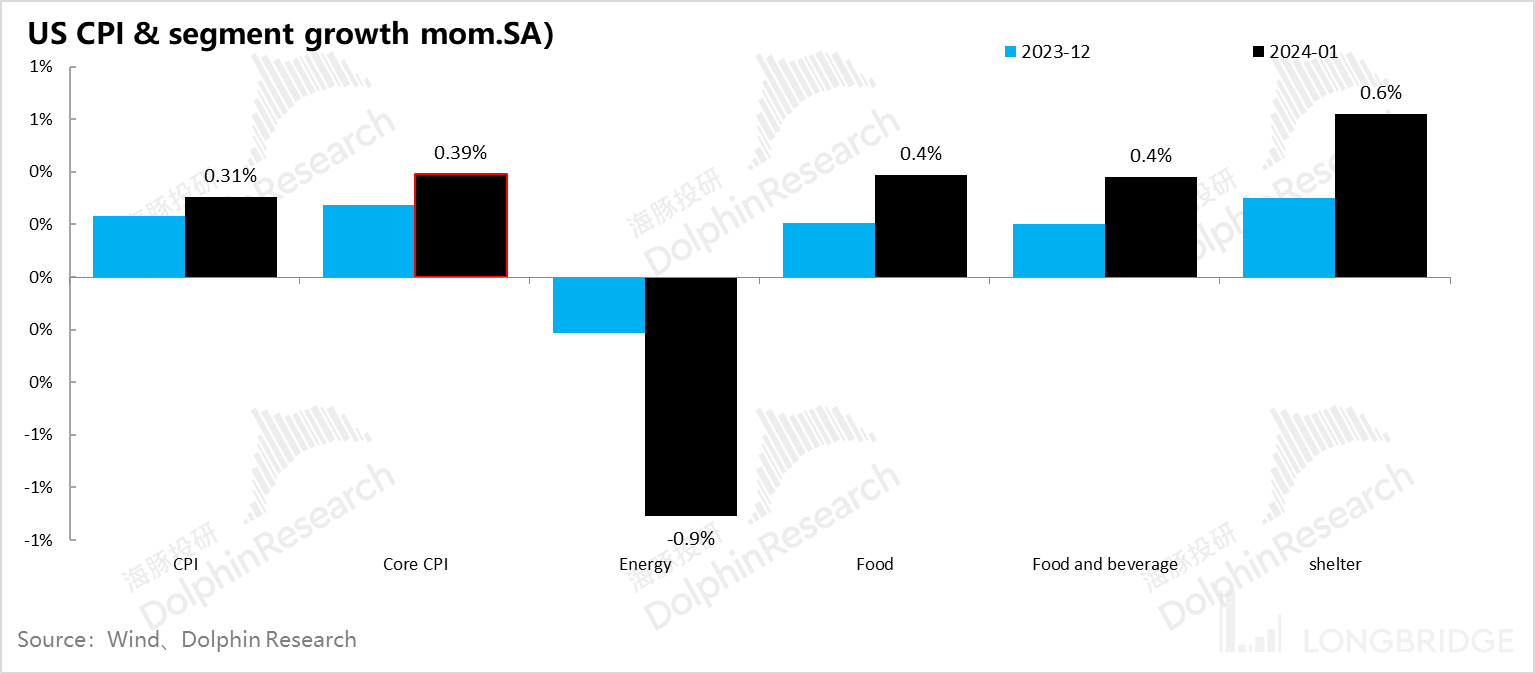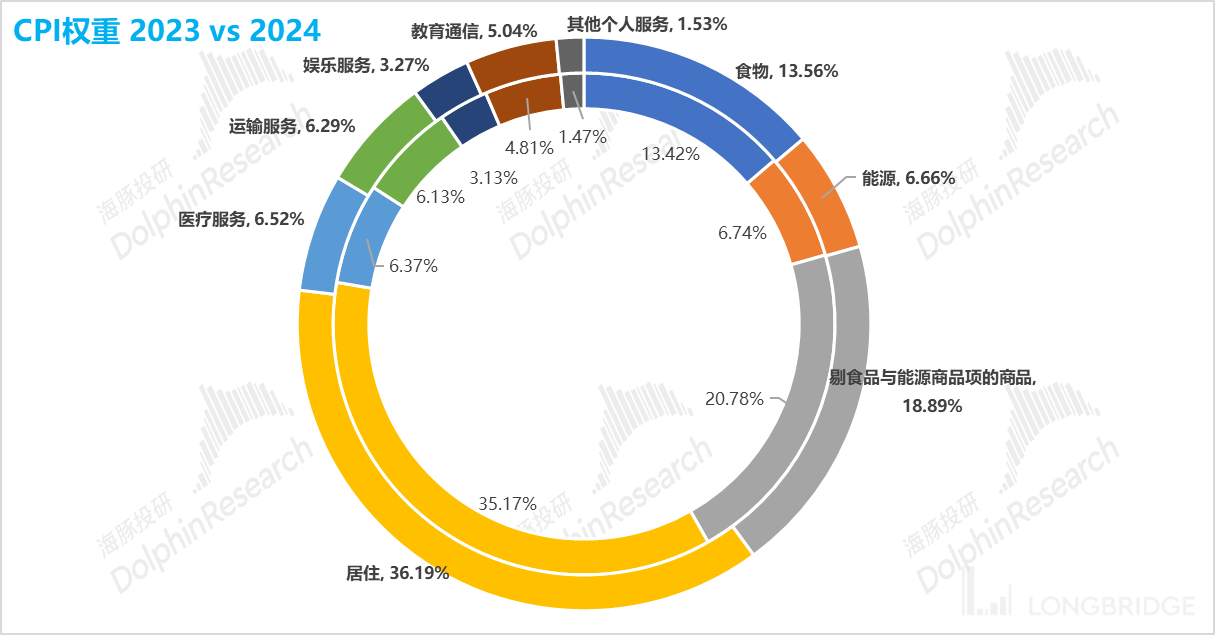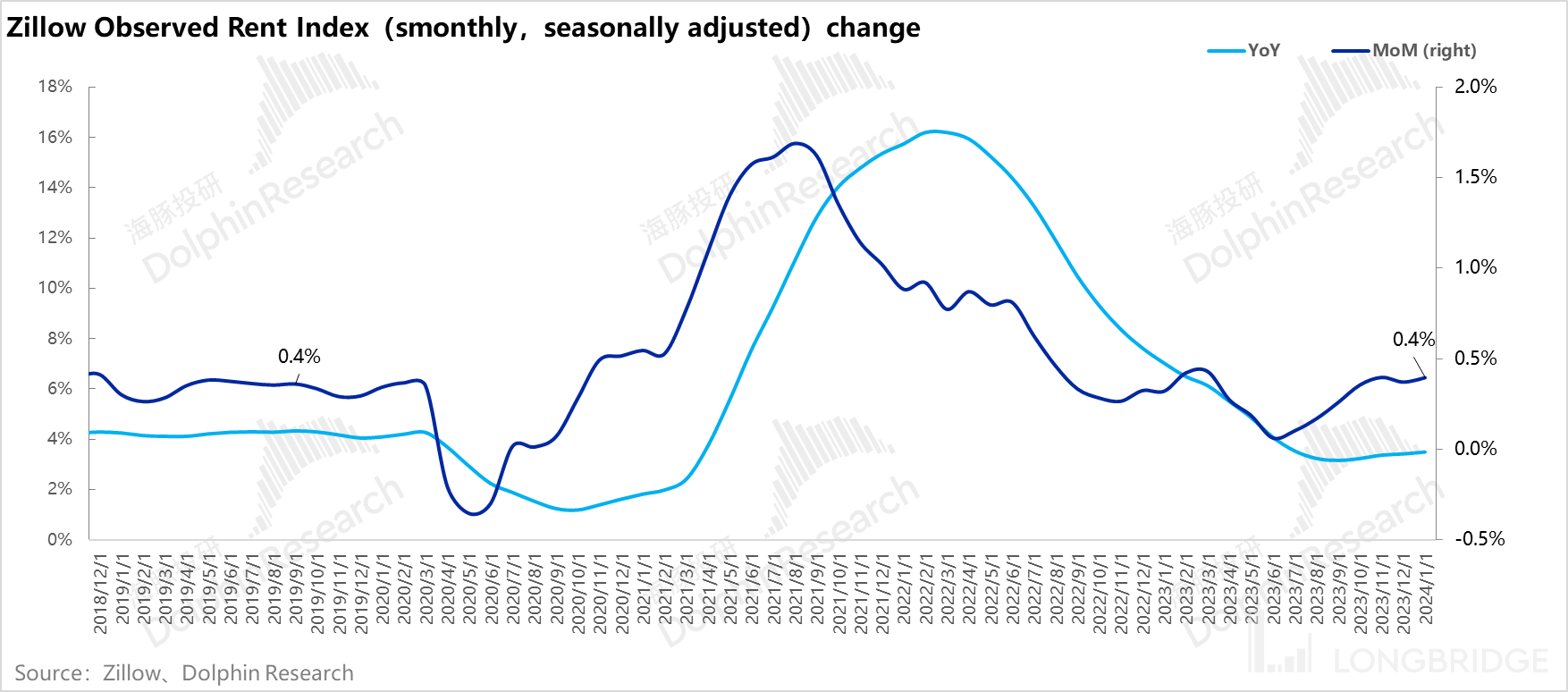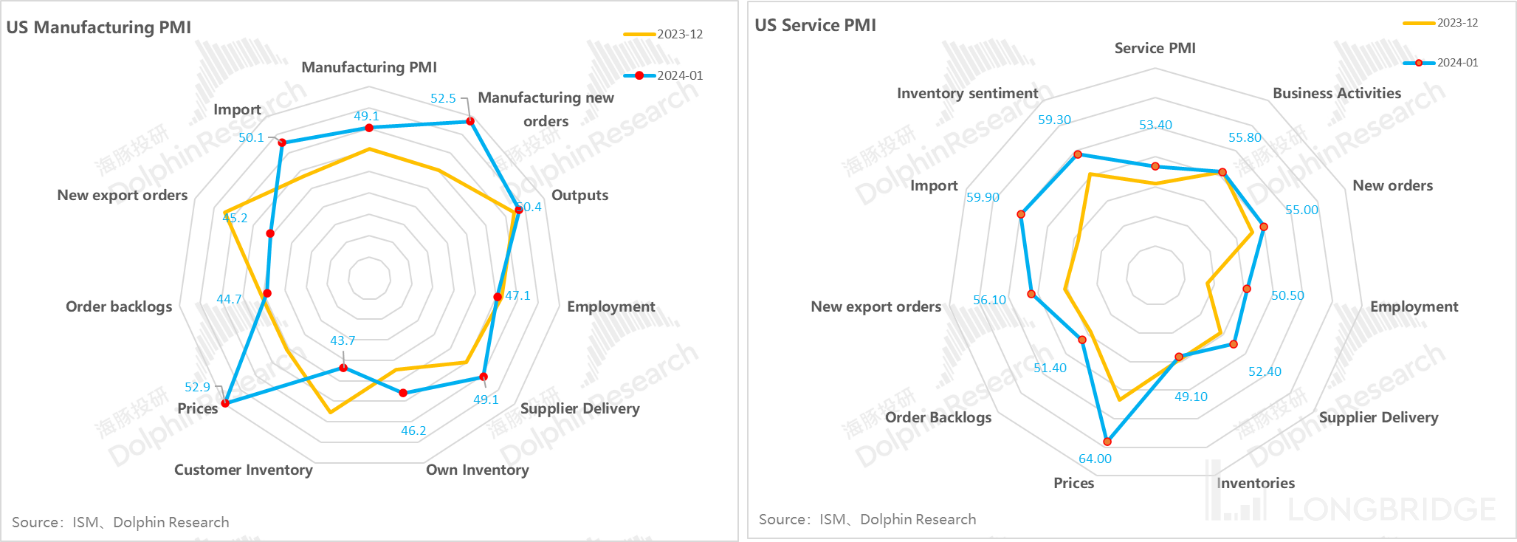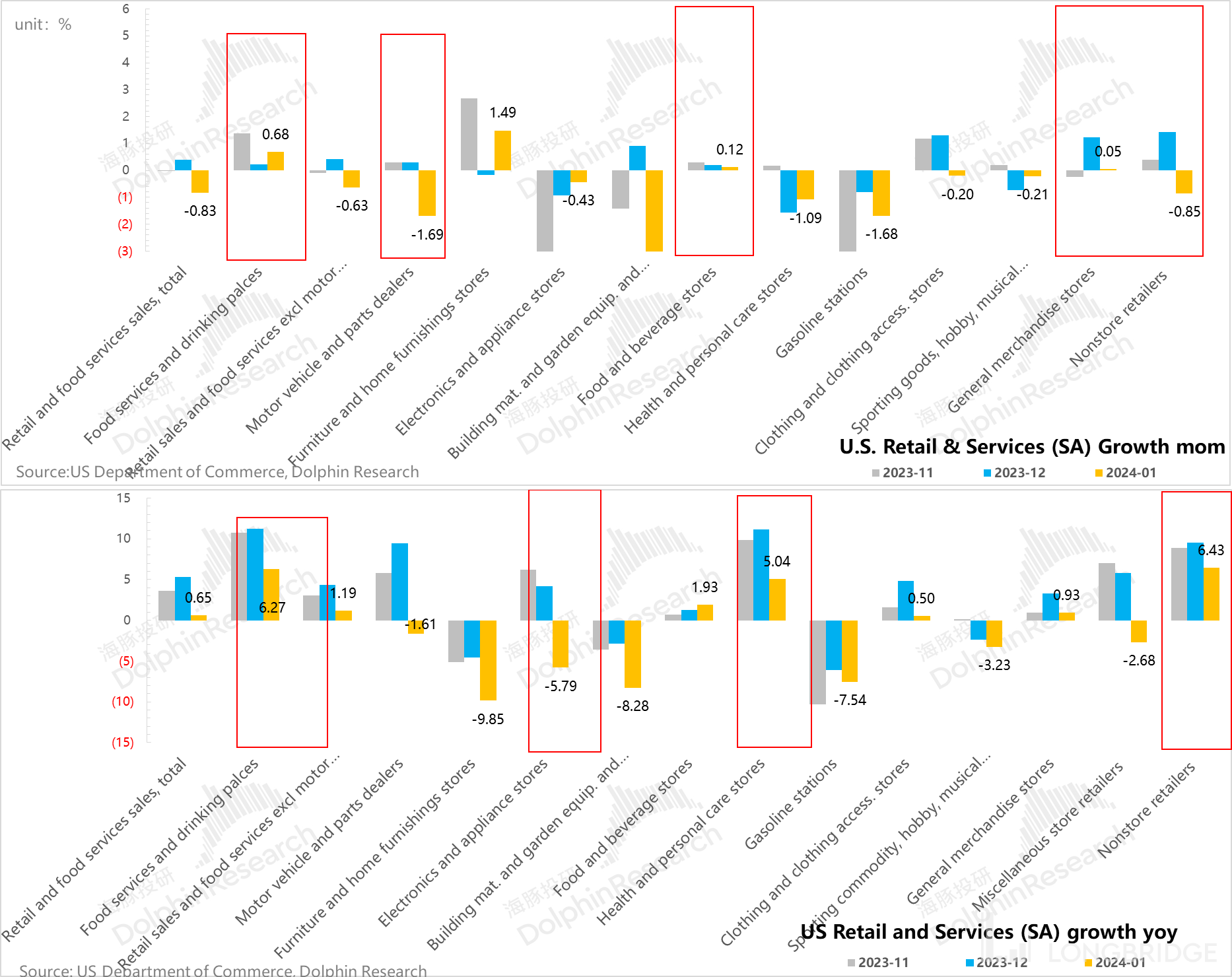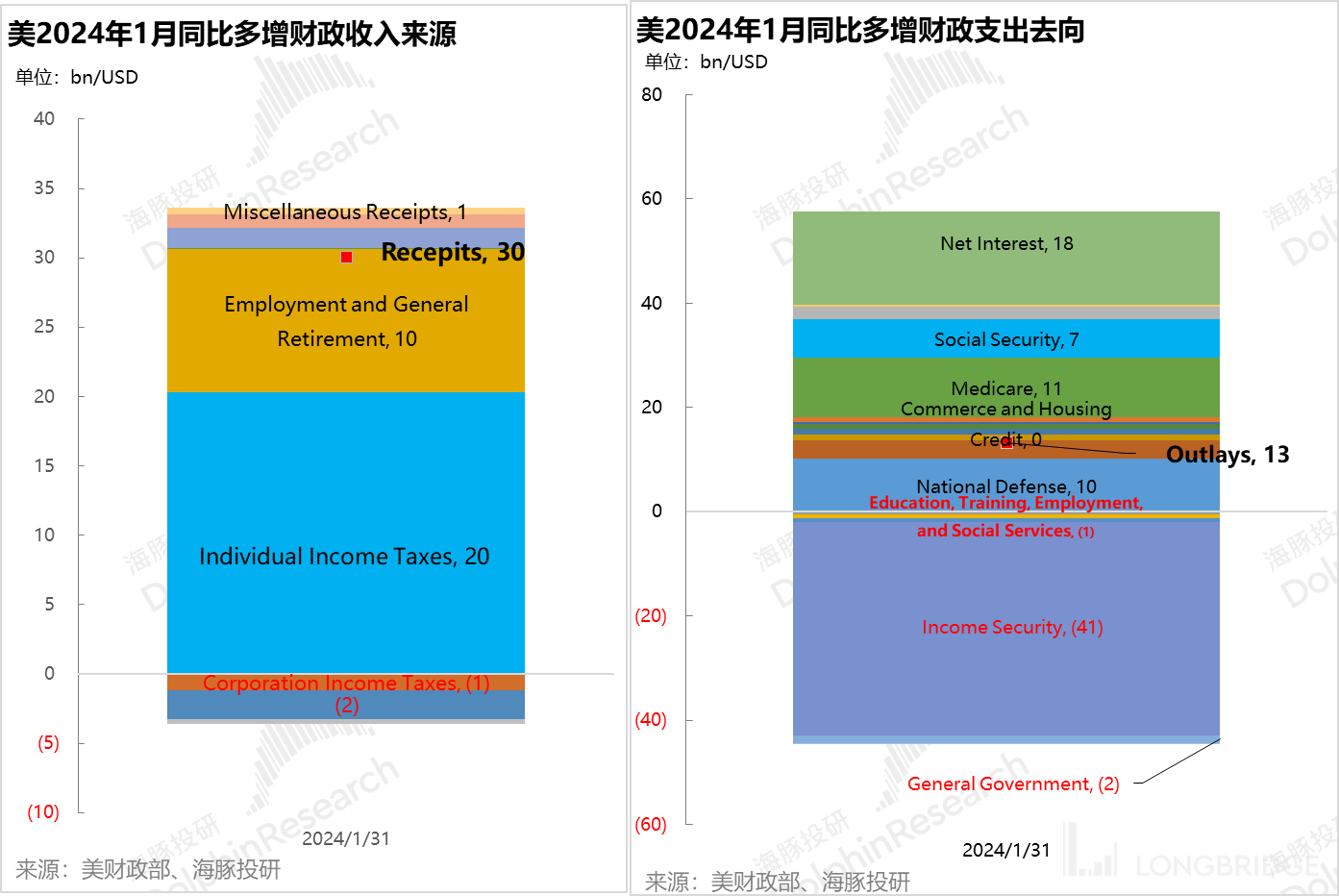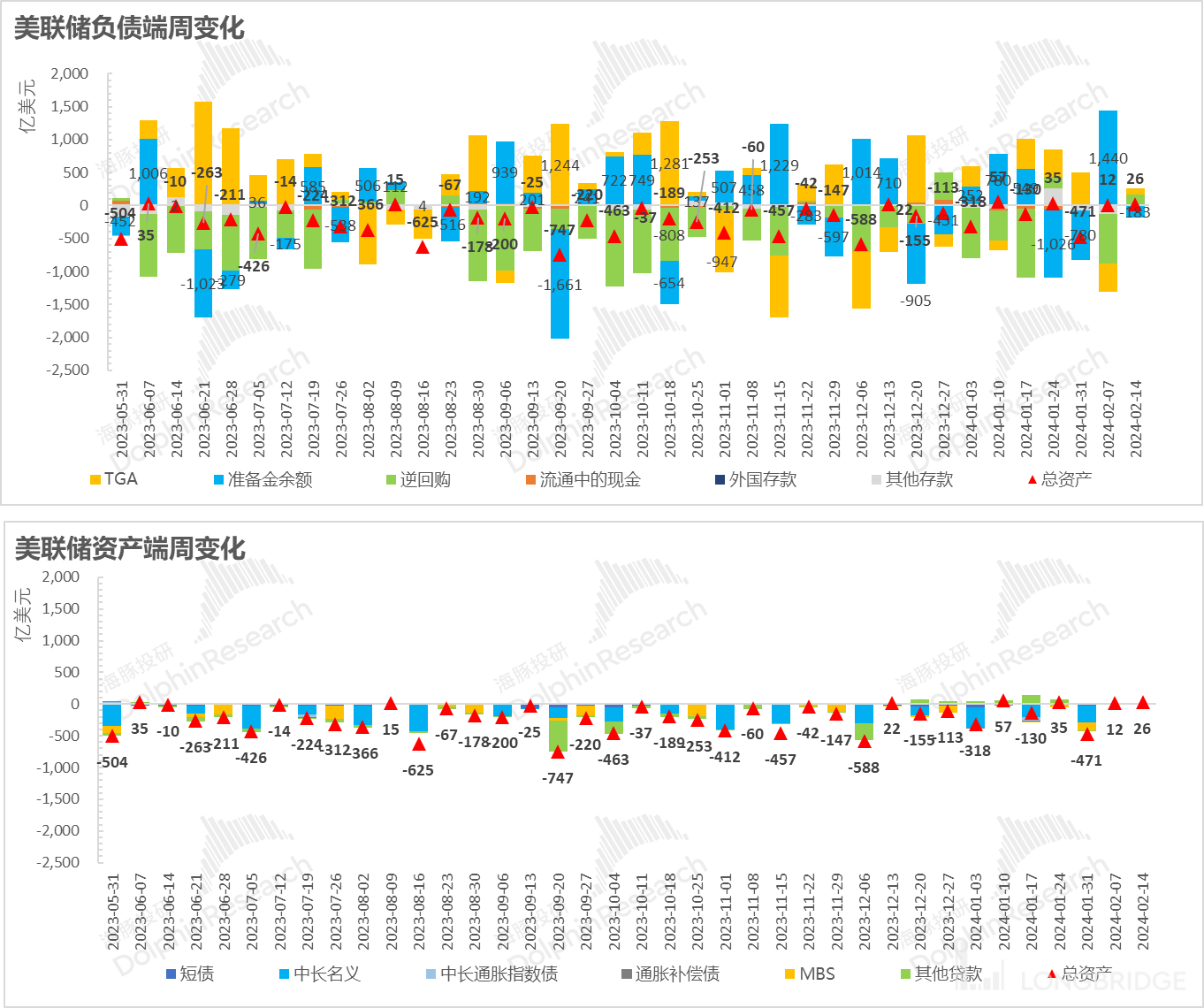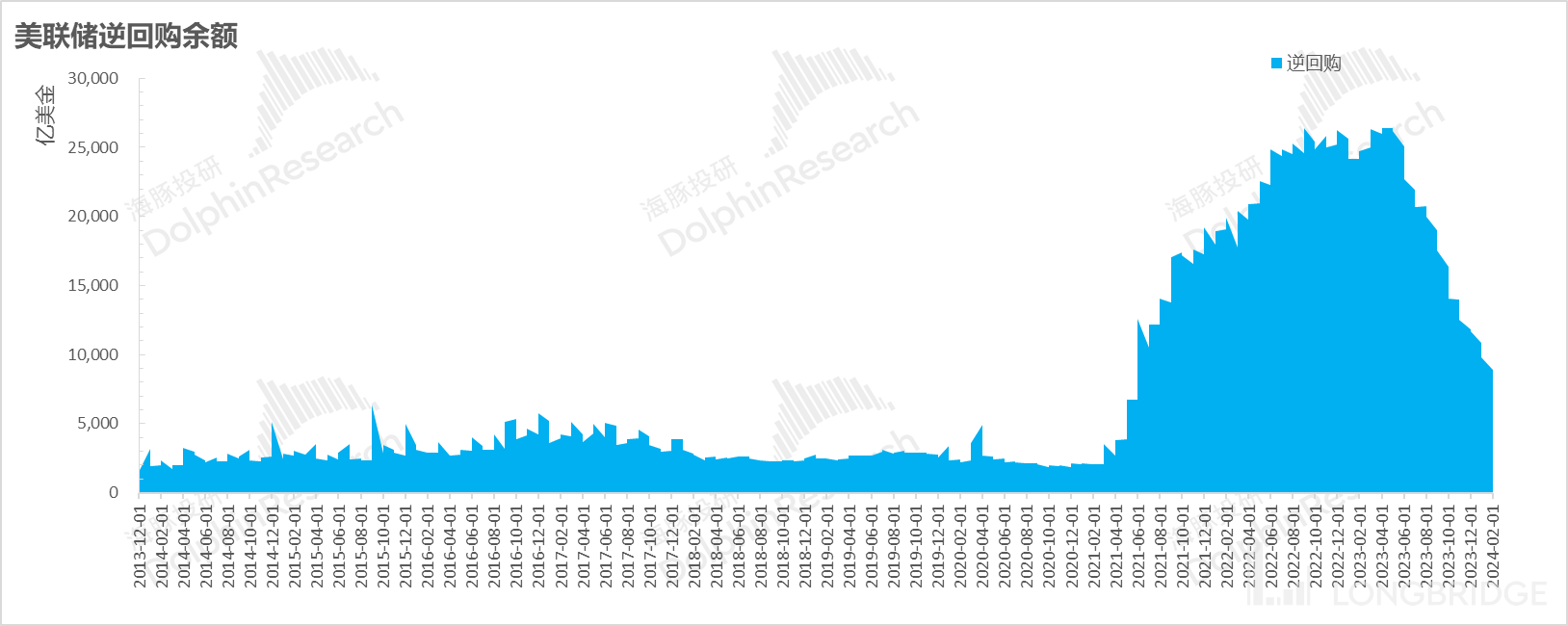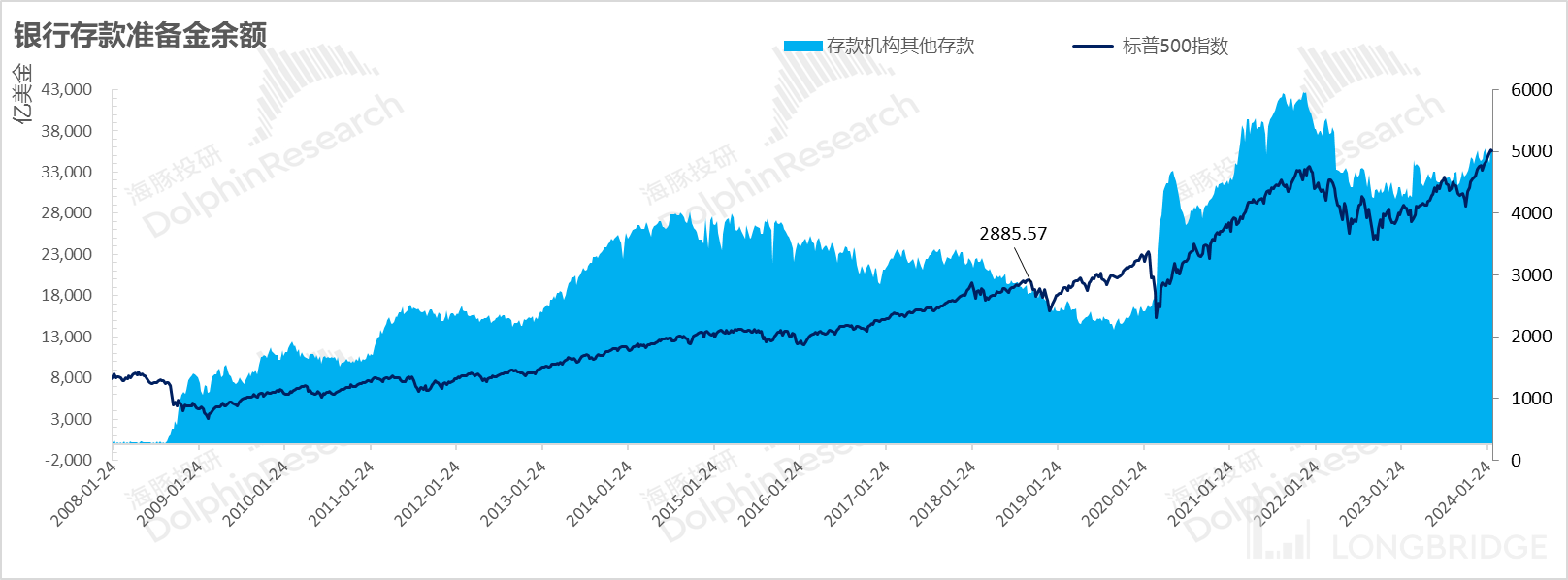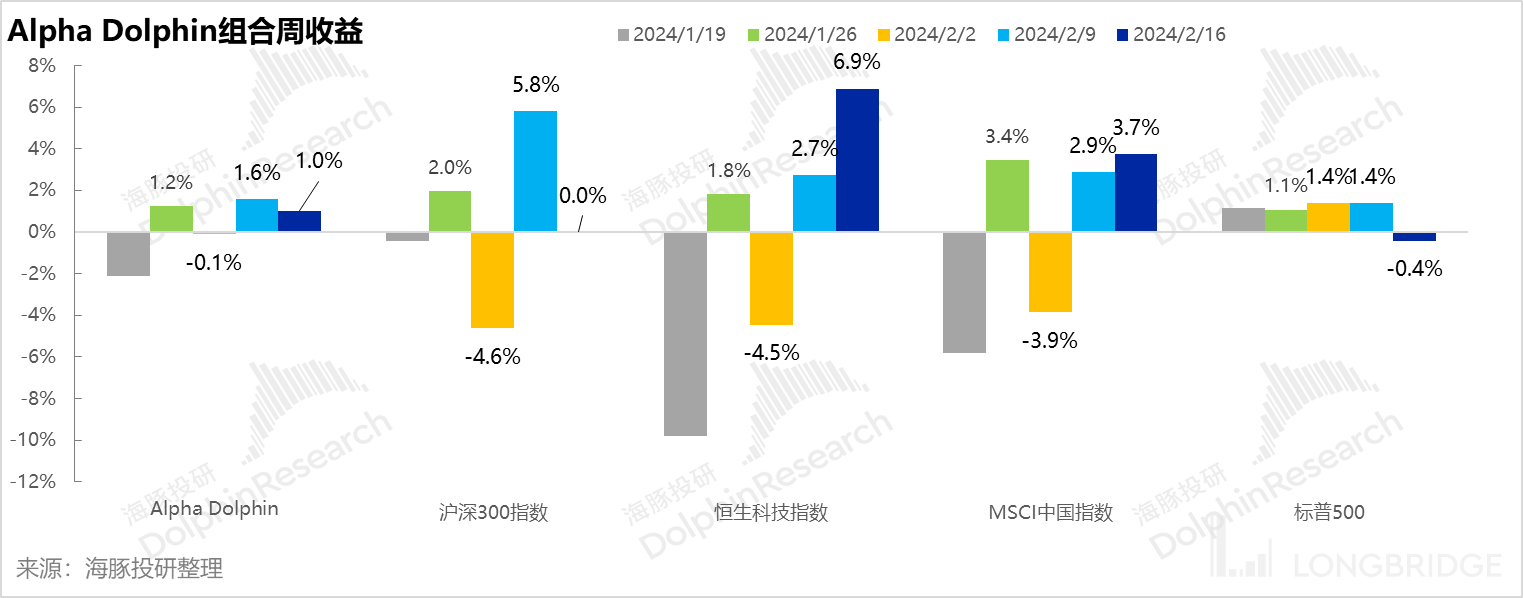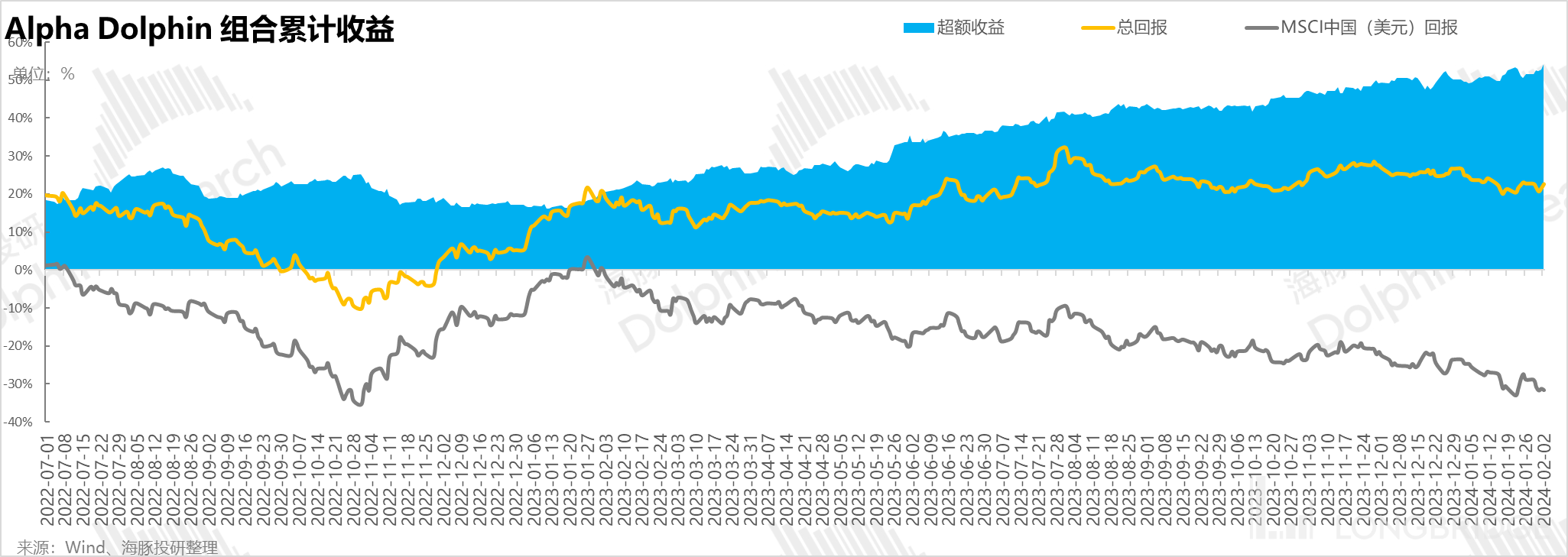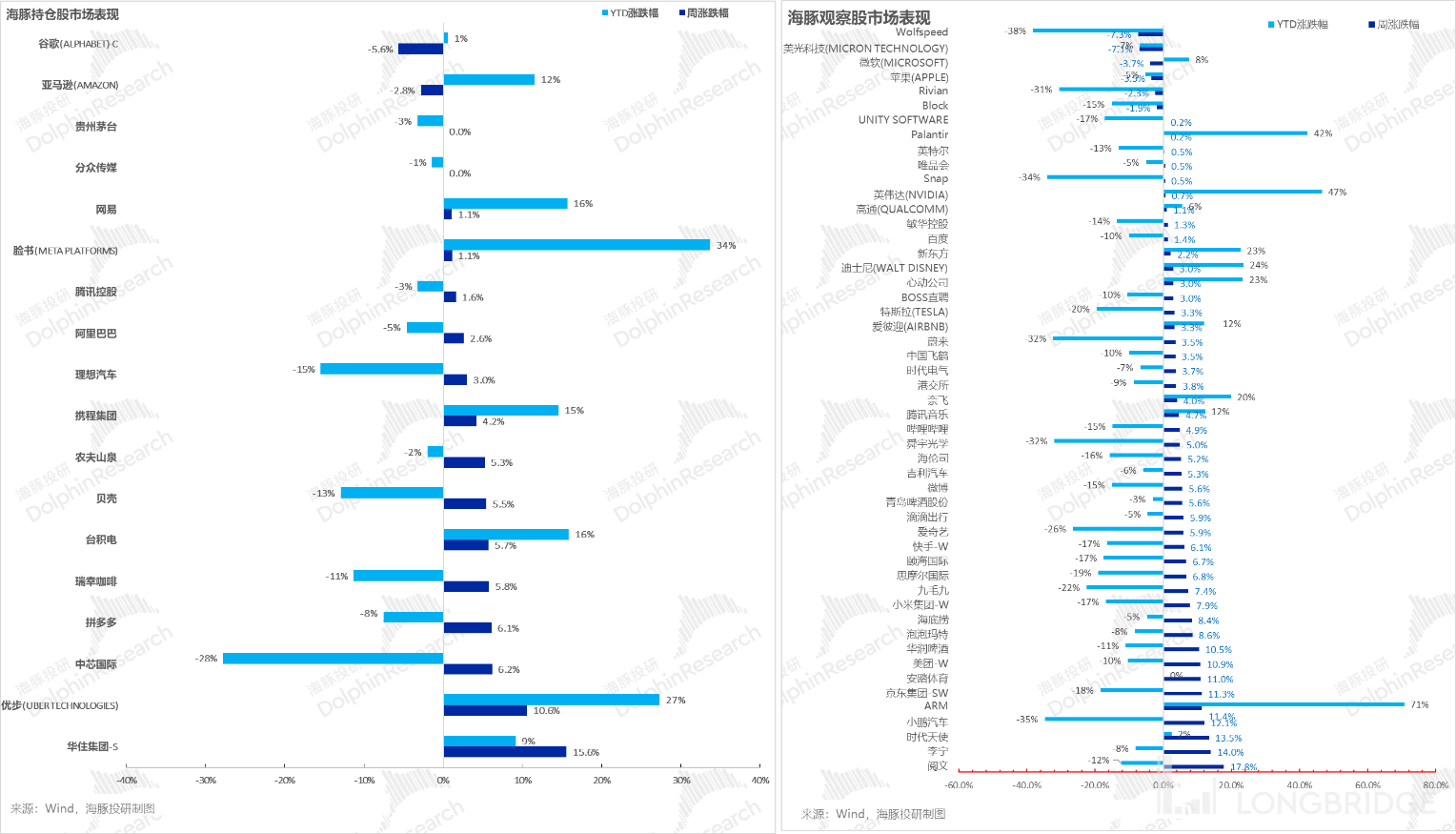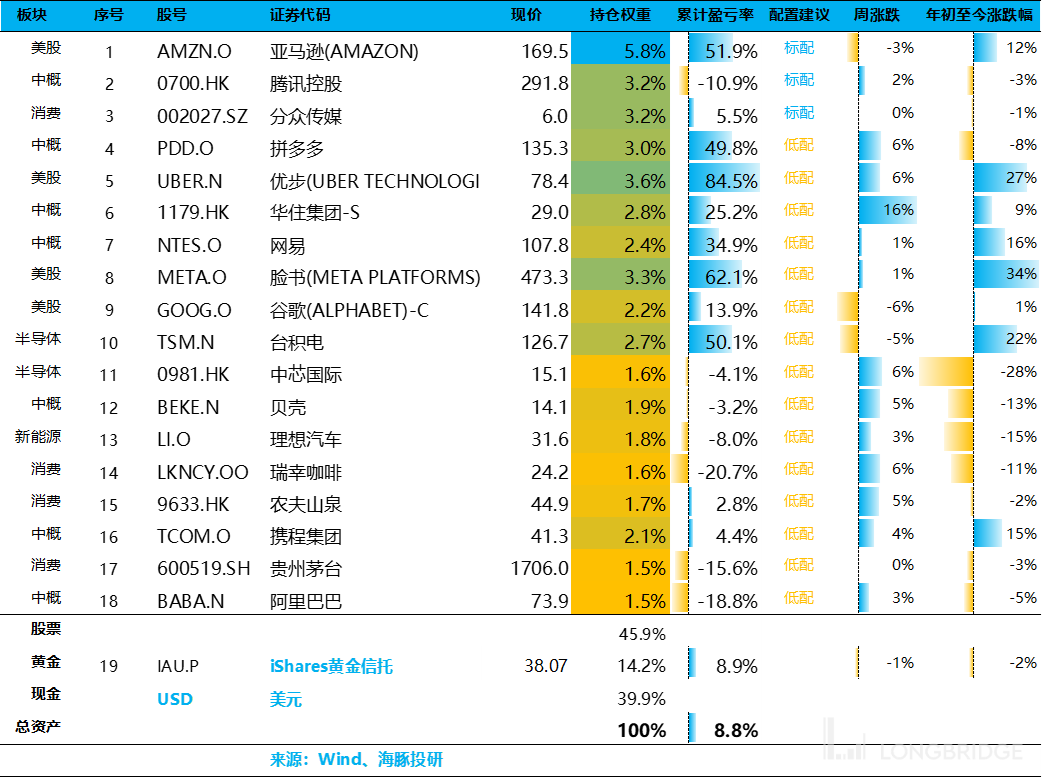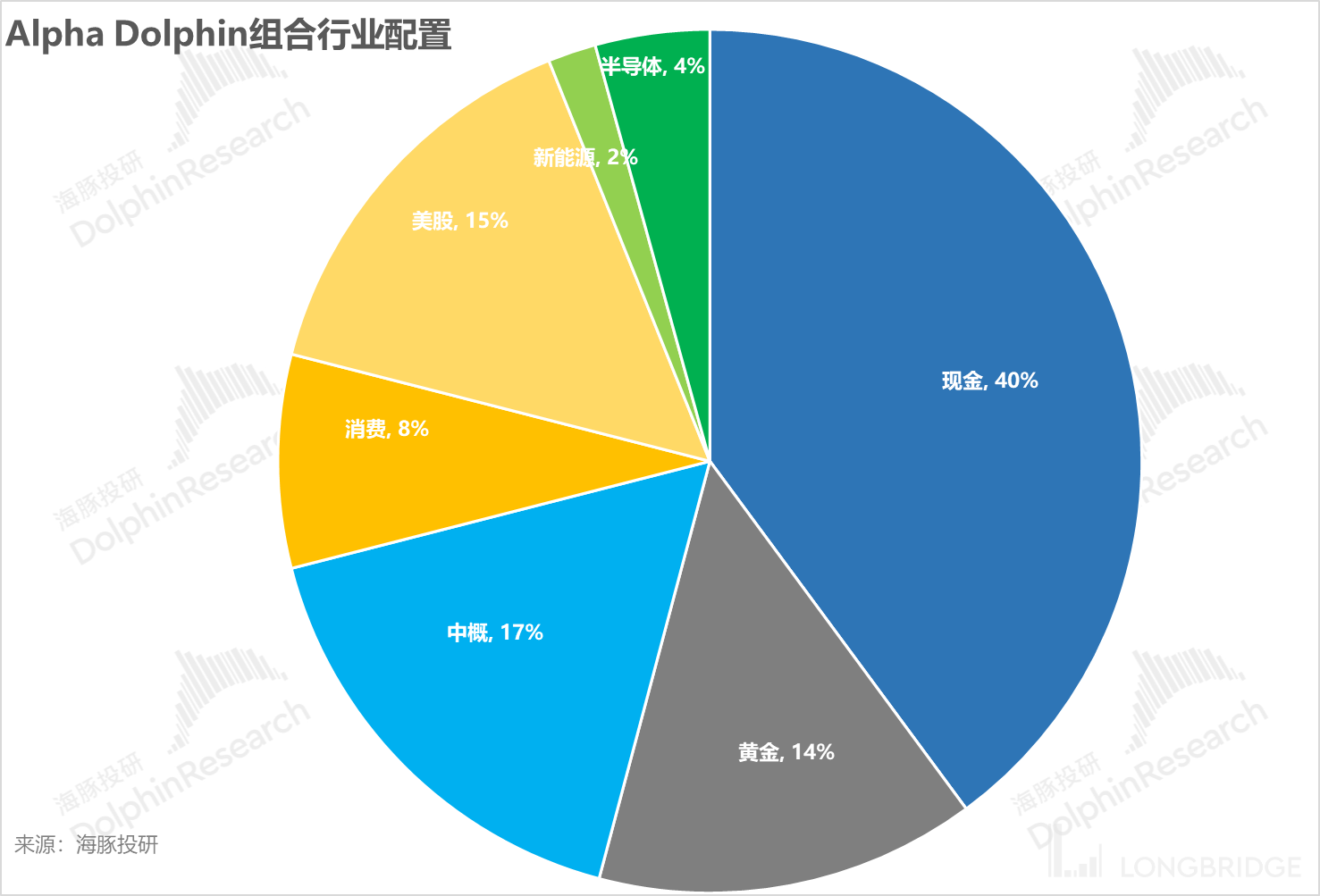
 Likes Received
Likes Received Posts
PostsMega 7 halt Rally, China Assets Recovered,Signs of a last hurrah or a shift in trend?

Hello everyone, here is the core information summary of Dolphin Research for this week:
I.In January, both the core and overall CPI in the United States saw a MoM increase, but a closer analysis reveals that the increase was influenced by weight adjustments and abnormal weather noise. If we exclude the noise, the core information mainly indicates that after the adjustment in housing costs following the real estate correction, the downward trend in housing costs may continue for some time. Additionally, with wages continuing to rise, the process of leakage inflation in healthcare, entertainment, education, communication, and personal services remains slow, almost precisely confirming the Fed's cautious approach to determining the timing of interest rate cuts.
II. In January, the US retail sales seemed to collapse MoM, but this should be attributed to weather conditions and excessive consumption in December. When looking at the two months together, it is actually consistent with the deflation trend in US commodity prices. Overall, retail sales are weakening in slow growth, but daily necessities and online consumption are relatively strong structurally.
III. In January, the US fiscal deficit significantly narrowed, with the narrow deficit even turning into a surplus excluding interest. However, considering the fiscal deficit arrangement for the 2024 fiscal year by the US Budget Office, the broad deficit rate including interest payments is around 5.5%, while the narrow deficit rate should be within 3%. The latter still exceeds the pre-epidemic level by about one percentage point, and the narrowing of the deficit relies on an increase in fiscal revenue rather than a reduction in fiscal expenditure.
Therefore, Dolphin Research's assessment of the fiscal policy for the whole year of 2024 is to correct from extremely loose to moderately loose. The fiscal policy is still characterized by being expansive and proactive.
IV. As of January, the macro incremental information still points to a scenario where the US economy in 2024 will not experience a hard landing or a soft landing. In this scenario, equity assets are likely to be overvalued, but the risk of performance pitfalls is relatively low.
Therefore, it may be worthwhile to focus on whether the change in liquidity after the excess balance of reverse repurchase in April and May will bring opportunities for valuation adjustments in the US stock market.
Currently, without any adjustments, the overall US stock market is still stagnant under the weight of giants, and opportunities can only be found in small stocks with good fundamental stories and not too poor fundamentals, which greatly tests stock selection capabilities.
Here are the detailed contents:
During the Spring Festival holiday, the vigorous holiday consumption in China, such as tourism and movie-watching, boosted the sluggish demand. In the US market, based on the CPI/PPI, retail sales, and federal fiscal data released in January, the US economy still appears to be on the path of "no landing."
I. Inflation Resurges in January
Firstly, the PPI saw a sharp increase. Although the MoM decrease in food and energy prices suppressed the rise in PPI, the core PPI showed a high increase, resulting in an overall MoM increase of 0.33% in PPI. Excluding energy, food, and trade, the core PPI surged to 0.57%, mainly driven by the core service PPI excluding trade warehousing, which soared by 0.82% MoM.

In the most closely watched consumer price index in the market, the US CPI for January also surged. Specifically:
a) Regarding food prices, whether dining in or ordering takeout, prices have increased, leading to a doubling of the overall food CPI to 0.4% MoM.
b) Energy prices decreased by 0.9% MoM, but within the energy sector, services such as electricity and pipeline gas actually increased, offsetting the overall decline in energy prices.
c) In terms of core goods, the prices of used cars, healthcare products, and clothing saw significant declines, resulting in a 0.3% MoM decrease in core goods CPI, indicating a continued deflationary trend.
d) As for core services, the main issue lies in the Owner's Equivalent Rent (OER) component within housing costs, which saw a direct increase of 0.6% MoM, pushing the overall core services MoM increase to 0.7%.
In other important core services, apart from a weakening in the price increase of entertainment services, sectors such as healthcare, transportation, education, communication, and other personal services are all on the rise.
The final outcome is that both the overall CPI (0.31%) and core CPI (0.39%) are in an upward trend.
Most prices were stabilizing or declining, so why did food and core services, apart from energy and core goods, return to an upward trend in January, causing a sharp turnaround in the overall CPI? Dolphin Research provides the following observations:
1) Weight increase in services and food, fueling the trend
Entering January 2024, CPI weight adjustment: Over the past year, the weights of energy and core goods, which have shown clear signs of inflation, were reduced, while the weights of core services and food, where inflation progress is slower, were increased. This adjustment means that even looking back over the past 12 months, the overall CPI and core CPI appear to have risen significantly in January due to the overall marginal increase in food and core service items.
In terms of specific items, the simultaneous rise in at-home food, takeout food, household electricity and gas, and highly volatile airfare transportation services seems to be somewhat related to the extreme snowstorm weather in the US in January. Projects unaffected by weather, such as healthcare and education communication, are on a stable upward trajectory.
In the core services sector, the real issue lies in housing costs, with the core CPI excluding housing costs showing a consistent MoM growth rate of 0.2% compared to the previous month.
The main factor driving the increase in housing costs is the single largest-weighted component, Owner's Equivalent Rent (OER), which accounts for a weight of 26.77% in the entire CPI, exceeding the sum of healthcare, transportation, entertainment, education communication, and other personal services. The MoM growth rate of OER increased by 0.6%, directly triggering a surge in the overall core service CPI.
The equivalent rent for homeowners is the estimated rent that owner-occupiers would pay if their own homes were rented out. From the actual changes in rental prices, the MoM increase in new lease rents has basically remained at 0.4%, with no significant changes.
It is necessary to pay attention to the expectation that the rental yield may rise more due to property price expectations. Currently, the supply of second-hand houses in the United States is tight, transaction prices are basically stable, and with the industry's low inventory, new housing market transactions and new construction have passed the bottom and are starting to rise slightly. It is important to observe whether owner-occupiers will have expectations of a sustained increase in rental yields as they enter the new year. It is crucial to monitor whether this trend continues in February, as it may affect the timing of interest rate cuts.
Another point of concern is that in the forward-looking indicators for January, whether it is the manufacturing PMI or the service PMI, the extent of price expansion is quite significant, with the service price PMI index directly reaching 64.
Overall, looking at January CPI, there are adjustments in weighting and noise from abnormal weather. If we exclude these factors, the core information mainly indicates that after the adjustment in real estate, the downward trend in living costs can continue for how long needs further observation. Secondly, in the scenario of continuous upward wage costs, the process of inflation leakage in medical, entertainment, education, communication, and personal services remains slow, almost precisely confirming the Fed's cautious approach to determining the timing of interest rate cuts.
The inflation information in January once again educates the market - Don't fight against the Fed. The market trading continuously relies on the Fed's guidance of starting interest rate cuts in the middle of the year, with a total of three interest rate cuts of 75 basis points in a year.
II. January's Retail Collapsed?
In January, the accelerating weakening of core CPI prices for goods is mutually confirmed by the social retail sales in January (excluding catering, which can be roughly seen as consumer goods in personal consumption). Seasonally adjusted (excluding inflation) after the surge in December, it dropped by 0.83% MoM in January, a significant decrease.
It can be seen that in January, consumption in catering establishments remains very strong, but the declines in other key high-weight categories such as automobiles and parts, general merchandise, and non-store retail are quite pronounced.
Comparing the average growth rates of December and January after seasonal adjustment with the growth rate in November, the overall consumer goods represented by social retail sales in the past two months have been flat, with daily department store retail and online retail showing marginal upward trends structurally, followed by clothing and catering.
Despite the impact of abnormal weather in January suppressing commodity consumption, the delayed release of key service consumption data, and the simultaneous increase in January's employment and hourly wages, the significance and information conveyed by social retail in January are far less important than the information conveyed by CPI and PPI.

III. Fiscal Policy in 2024 Remains Broad Acommadative
In January, on the federal fiscal front, there was a rare positive turn in individual income tax revenue, while expenditure-wise, there was a significant reduction in income security expenditures, mainly due to the continued decrease in public health spending related to the epidemic.
As a result, the fiscal deficit in January was only $22 billion, significantly lower than the average monthly deficit of around $180 billion in previous months. Excluding interest costs, there was a slight surplus in January, partly due to timing differences in receipts and payments between December and January.
In the first four months of the 2024 fiscal year (October to January), the fiscal deficit (adjusted for payment timing changes) was $60 million, $8 million more than the same period last year.
According to the expectations of the U.S. Congressional Budget Office, the federal government's planned fiscal deficit for the entire 2024 fiscal year is $1.5 trillion, while the actual deficit for the previous fiscal year was $1.7 trillion. Excluding payment timing changes, the deficit should decrease by $100 billion compared to the previous fiscal year.
In summary, the message is simple: in the remaining eight months, the average monthly deficit needs to drop from the current $1.5 trillion to around $1.1 trillion.
Based on the fiscal deficit plan for the 2024 fiscal year, Dolphin Research estimates that the broad-based deficit rate for the U.S. in 2024 should be around 5.5% (relative to nominal GDP), while the narrow deficit rate after debt interest payments should be close to 3%, compared to within 2% in the previous quarters before 2019.
In other words, even though the extreme fiscal measures in 2024 will be somewhat restrained, it will still be relatively high compared to pre-epidemic years, indicating that fiscal policy remains relatively loose.

With the current high employment, rapid wage growth, and a tight labor supply trend, the government's fiscal policy has only shifted from extremely loose to relatively loose, assuming a 75 basis point rate cut in the second half of the year. Under this macro combination, Dolphin Research believes that from the perspective of economic fundamentals, in 2024, the US economy is likely to either not land or experience a soft landing.
IV. How much excess liquidity is still waiting to be consumed?
Looking at the Federal Reserve's balance sheet, in the past two weeks, the Fed has not sold any US Treasury bonds. Therefore, the Fed's total assets have remained basically unchanged, but there have been significant changes on the liability side: reverse repurchase agreements are still being rapidly consumed, with a balance of $900 billion remaining as of February 14th.
Based on the current consumption rate, starting from April or May, if the Fed continues to sell Treasury bonds at the current pace, the balance will drop back to around $500 billion, the level before the pandemic. Subsequently, further quantitative tightening may require the consumption of bank reserve balances.
Looking at the trend since 2021, the movement of the S&P 500 index is highly consistent with the trend of reserve balances in the US banking system. It is still necessary to pay attention to the potential risk of valuation compression at that time.
However, due to the economic fundamentals still leaning towards a soft landing or no landing, as long as the fundamentals remain sound, a stock market pullback could actually present a buying opportunity.
V. Summary of US Stock Earnings Season
Regarding the recent earnings season of major companies, despite the overall high valuation, there are two main characteristics that have led to decent gains: substantial outperformance in performance and guidance, such as Amazon, or performance that meets expectations with the boost of buybacks, as seen with Uber and Disney, with gains of around 10%; the strongest performers like Meta and Netflix have seen gains of around 20%.
For major companies with performance that is still acceptable or barely acceptable, such as Google, Apple, and Microsoft, they are already in a state of stagnation. With high valuations and slow inflation decline, further upward pressure on valuations is already significant. This assessment is similar to Dolphin Research's previous overview of the US stock market in the article "Can Giants Dominate the World Forever? Can Microsoft, Google, Amazon, and Meta Remain Invincible?". When the giants are stagnant as a whole, funds tend to seek opportunities in small-cap stocks. AI small-cap stocks with compelling stories and solid foundations are currently thriving amidst the chaos, such as ARM and Palantir tracked by Dolphin Research, with gains since the earnings report typically around 50%. At present, the opportunities in small-cap stocks seem more promising compared to the overvalued tech giants.
Overall, as we approach the liquidity observation point in April, the alpha capabilities of US stock giants have significantly weakened, prompting the market to shift towards "mining" in small companies with compelling stories or solid foundations. Stock selection is expected to become more challenging.
VI. Portfolio Returns
In the two weeks from February 9th to February 16th, the virtual portfolio returns of Alpha Dolphin increased by 2.7% and 1.7% respectively, weaker than MSCI China and Hang Seng Tech, but stronger than the S&P 500.

From the inception of the portfolio to last weekend, the absolute return of the portfolio was 26%, with an excess return of 53% compared to MSCI China. In terms of asset net value, Dolphin Research's initial virtual assets of $100 million have now risen to $127 million.

VII. Individual Stock Performance
The recent fluctuations in the holdings and observed stock pools of Dolphin Research in the past two weeks were mainly driven by two factors: a) fluctuations in US stocks driven by earnings season, such as ARM and Palantir; 2) undervalued rebounds in Chinese concept stocks driven by strong travel consumption during the Spring Festival.

Regarding the major companies with significant fluctuations in Dolphin Research's holding pool and watchlist during the Spring Festival week, as well as the possible reasons, Dolphin Research's analysis is as follows:

VIII. Portfolio Asset Allocation
In the past two weeks, there have been no adjustments to the Alpha Dolphin virtual portfolio, with a total of 18 stock holdings, including three core holdings, while the remaining equity assets are underweighted, with the rest in gold and US dollars.
As of last weekend, the asset allocation and equity asset allocation weights of Alpha Dolphin are as follows:


Ⅸ. Key Events of the Week
This week, the U.S. stock market officially entered the prelude to the earnings season of small and medium-sized companies and Chinese concept stocks. The specific focus points are summarized by Dolphin Research as follows:

Risk Disclosure and Statement of this Article: Dolphin Research Disclaimer and General Disclosure
For recent articles from the Dolphin Research Weekly Portfolio, please refer to:
"In 2024, will the U.S. economy avoid a hard landing?"
"Another critical moment! Will Powell bail out the spendthrift Yellen?"
"Seeing the mud and sand again, how much faith can withstand the test?"
"Unstoppable deficits, supporting the dignity of the U.S. stock market"
"2024 U.S.: Good economy, quick rate cuts? Too optimistic, will suffer losses"
- "2023 American Suicide Rebirth"
- "Fed Makes a U-turn, Can Powell Resist Yellen?"
- "Year-end US Stocks: Small Gains Bring Joy, Big Gains Harm Health"
- "Consumer Cooling Off, Is the US Fed Really Just a 'Tough-Talking' Central Bank Before Rate Cuts?"
- "US Stocks Overdrawn Again, Finally a Chance for Chinese Concepts"
- "The 'Sun Never Sets' Faith in US Stocks Returns, Is It Reliable This Time?"
- "High Interest Rates Fail to Douse Consumer Spending, Is America Really Thriving or Just Hype?" Under the tightening of the Federal Reserve, neither stocks nor bonds can escape!
Getting down to earth, Dolphin Research's investment portfolio is up and running!
The copyright of this article belongs to the original author/organization.
The views expressed herein are solely those of the author and do not reflect the stance of the platform. The content is intended for investment reference purposes only and shall not be considered as investment advice. Please contact us if you have any questions or suggestions regarding the content services provided by the platform.


